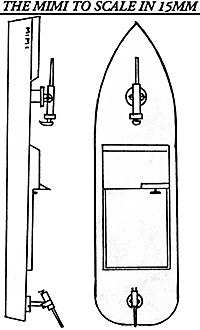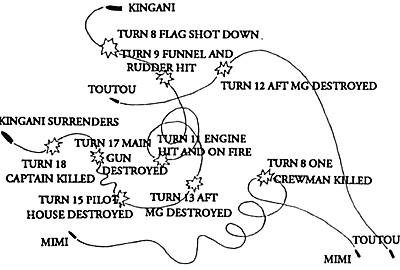 Lake Tananyikia in Central Africa, is a vast inland sea measuring some 400 miles long. During World War I, it formed the western boundary of German East Africa. The lake served as an arena for a small but important campaign during the war. The Germans achieved control of the lake early in the war. They had several gunboats on the lake, whereas the British and the allies had none. Their undisputed control of the lake safeguarded the western boundary of the German colony. The allies dared not move along the lake for fear of the Germans landing troops to their rear. Therefore, in April, 1915, the British devised an ingenious plan which would allow them to take control of the lake.
Lake Tananyikia in Central Africa, is a vast inland sea measuring some 400 miles long. During World War I, it formed the western boundary of German East Africa. The lake served as an arena for a small but important campaign during the war. The Germans achieved control of the lake early in the war. They had several gunboats on the lake, whereas the British and the allies had none. Their undisputed control of the lake safeguarded the western boundary of the German colony. The allies dared not move along the lake for fear of the Germans landing troops to their rear. Therefore, in April, 1915, the British devised an ingenious plan which would allow them to take control of the lake.
The British Admiralty secretly shipped two armed motor boats, the Mimi and the Toutou, to Cape Town in June, 1915. The ensuing 2,800 miles overland trek to Lake Tananyikia presented almost insurmountable obstacles and called for the building of over 200 bridges. Despite the difficulties, the boats finally arrived at Lake Tananyikia in late October.
The boats and ships battling for control of the lake were much smaller than those fighting in the main fleets. The Mimi and Toutou were each 39 feet long, 7 feet wide, and displaced only 4.5 tons apiece. They had a top speed of about 15 knots. Each boat had a 3-pound gun in the bow and a maxim machine gun in the stern. The 3-pdr could only be fired directly to the front or the recoil would tear it from it's mount The Germans had 3 gunboats on the lake. The Kingani, a 53-ton tugboat, was 55 feet long with a 37mm Hotchkissgun mounted on the forecastle. Her top speed was less than seven knots. The 150-ton Hedwig Yon Wissman, was a 70-foot wooden steamer with two 6-pdr guns in the bow and a 37mm Hotchkiss aft. The 1500-ton Gotzen, a 200-foot steamer, was the flag ship of the small German fleet. She mounted a 4" gun and two smaller guns taken from the cruiser Koingsberg. The Wissman had a top speed of ten knots and the Gotzen could only achieve about six knots.
The Germans used the gunboats to bombard Belgian towns and transport troops. They could move 900 troops by water from one end of the lake to the other in two days. The allies required two weeks to make the same distance over land.
The day after Christmas, 1915, the Kingani sailed to shell the port facilities at Lukuga. However, the Mimi and Toutou were lying in wait ready to contest thie unknowing Germans for control of the lake. The British commander, Lieutenant Commander Simpson, was aware of the Kingani's top speed of 7 knots in contrast to the British boats' 15 knots. Knowing the German main gun could only fire to the front, Simpson used his speed advantage and circled around behind the Kingani.
The battle was short and deadly only lasting 11 minutes. The British opened fire at 2000 yards and then closed in to 1100 yards for the kill. The Germans managed to get one minor hit on the Mimi. However, the British fire was devastating. One shot destroyed the Kingani's main gun and killed her captain. Another killed the first mate. Additional fire killed three more crewmen and stunned the helmsman. Finally, the Kingani s chief engineer hauled down the battle flag and surrendered.
The British renamed the captured Kingani the HMS Fifi. On 9 February 1916, the British assumed the offensive to seize control of the lake. The Fifi, now mounting a 12-pdr on the forecastle and a 3-pdr gun aft, along with the Mimi (the Toutou had been damaged in a storm) encountered the German steamer Wissman. The three ships fought desperately for 3 hours in a 30-mile running fight.
At first, the Wissman was able to draw clear of the Fifi. The 12-pdr fun was too large for the Fifi and each time it was fired the recoil stopped the small ship dead in the water. However, the Mimi darted ahead and opened fire on the Wissman at 300 yards. The Wissman could not return effective fire with her aft mounted 37mm Hotchkiss and had to turn to bring her forward guns to bear. Eventually the Fifi was able to close the distance with the German ship. The Fifi's fire was ineffective at first.
The Mimi then began to send corrections with flag signals. With the Mimi's help, the Fifi scored several critical hits. One shell went through the deck and burst in the engine room blowing a large hole in the Wissman's side. The battle ended with the Wissman on fire, engines stopped, steering gear shot away and sinking fast. The Germans tried to lower a boat, but it was so shot up that it also sank. The German crew eventually abandoned the burning Wssman just before she sank. The British did pick up 12 German and eight native crewmen. The European engineer and several native crewmen had been killed in the battle. On the following day the Graf Von Gotzen was sighted near the British base at Lukuga. To everyone's surprise, the British commander, Spicer-Simson, refused to engage.
In April the British flotilla cooperated with the Belgians. The Belgians used the boats to transport men and supplies for a seaplane base at Tongwe. The intent was to use the seaplanes to bomb the Gotzen. During May the 3 British ships (the Toutou had been repaired) cooperated in a British advance against the fortress at Bismarckburg. The local British commander ordered Spicer-Simson to guard the harbor entrance and prevent the Germans from escaping. Inside the harbor were five sailing dhows (about 100 tons each). The British officers and sailors begged for permission to sail into the harbor and engage the dhows, however, Spicer-Simson once again was unwilling to risk his reputation of the glorious victories over the Kingani and Wisman. Eventually the German garrison escaped in the five dhows.
By June, 1916, the Germans could no longer effectively resist the combined allied naval and land offensive along the lake. They scuttled the Von Gotzen and retreated inland, abandoning control of the lake to the British.
 WARGAMING THE NAVAL BATTLES FOR LAKE TANANYIKIA
WARGAMING THE NAVAL BATTLES FOR LAKE TANANYIKIA
All the boats and ships which fought for the lake are small enough to easily build in 15mm or 25mm scale. The Mimi and Toutou are only 4" long in 15mm. The Kingani only measures 5.5" in 15mm.
The Ballantine Book noted in my sources has a nice line drawing of the Mimi. Marshall Cavendish's Illustrated Encyclopedia of WW1 also has several pictures of the Mimi and Toutou (I obtained this book through a library loan and unfortunately did not record the data needed to properly list it in my sources). Shown in the accompanying figure is a simple line FULL SIZE drawing of my British gunboats.
I have been unable to find any pictures of the German gunboats. Paging through several WWI additions of Jane's Fighting ships gave me some good ideas : Several of the listed sources also give some hints on their appearance: The Kingani was a 53 ton tugboat 55 ft. long and mounted a Hotchkiss gun with shield in the forecastle. The Hedwig Von Vrissman was a 150 ton wood burning steamer 70 ft. long with 2 6-pdr guns mounted forward and a 37mm. Hotchkiss aft. Other info indicates that the wheel was mounted close to the stack and she had tall white sides and a ship's boat.
We fought the table top action using modified tables from M.O.D. Games Fast Attack. The battle with the Kingani lasted 20 game turns.
The wargame action opened with the British motor boats coming out of their harbor and cutting off the German escape route. The British plan was to attack from both flanks allowing one boat to draw fire and the other to move in for the kill. By turn 7, the British had closed the range sufficiently enough to start achieving hits. The Mimi and Toutou because of their small size and speed, proved very difficult to hit. The German player had to turn his ship towards one of the motor boats to bring its main gun to gear. The threatened motor boat would then turn away from the Germans making itself a difficult target to hit. On the opposite flank, the other motor boat was then free to close in almost unopposed (being careful to stay out of effective range of the Kingani's stem mounted MG).
On turn 8 a lucky shot downed the Kingani's battle flag, providing and early premonition of the battle's outcome. On rum 9, both the Mimi and Toutou scored serious hits. The Mimi's shot damaged the K~ingani's funnel which further reduced the German's already slow speed. The Toutou's shot hit the German's rudder forcing the ship to rum continually to the right. The Kingani " scored a hit on the Mimi which caused minor structural damage and killed one British crewman.
The Kingani circled helplessly to the right from turn 9 to 11. Both motor boats circled around behind the Kingani and engaged with almost total impunity. On turn 11, a critical hit caused an engine room fire on the Kingani. The German player staged a small comeback on turn 12 by repairing the rudder, extinguishing the engine room fire and destroying the aft MG on the Toutou. The Toutou retaliated on turn 13 by destroying the Kingani's aft MG.
The next several turns sealed the Kingani's fare. On turn 15 British fire destroyed the Kingani's pilot house. Turn 17 saw the Kingani's main gun destroyed and the German captain killed on turn 18. By rum 20, the German player accepted the hopelessness of his situation and surrendered.
BIBLIOGRAPHY
Dupy, Trevor N.,Naval and Overseas; War, 1916 - 1918New Yodc- Franklin
Watts, Inc, 1967.
Hoyt, Edwin P., The Germans Who Never Lost. New York; Funk and
Wagnalls, 1968.
Hoyt. Edwin P.,Guerrilla. New York: MacMillan Publishing Co., Inc., 1981.
Miller, Charles Battle for the Bundi. New York: Macmillan Publishing Co.,
Inc, 1974.
Sibley, J.R., Tanganyikan Guerilla and East African Campaign. New York.
Ballantine Books, 1971.
Back to Table of Contents -- Courier # 59
To Courier List of Issues
To MagWeb Master Magazine List
© Copyright 1992 by The Courier Publishing Company.
This article appears in MagWeb.com (Magazine Web) on the Internet World Wide Web.
Other articles from military history and related magazines are available at http://www.magweb.com